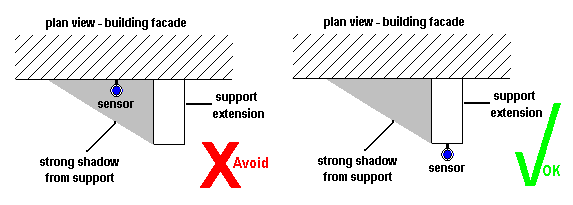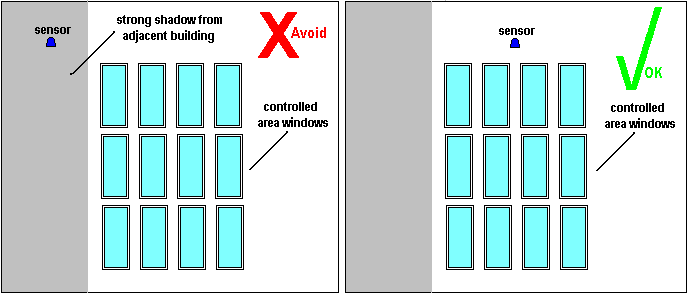
Working with Open Loop Scene Recall

 |
Working with Open Loop Scene Recall |
 |
|
Open Loop Scene Recall control is a method of automating the operation of the system’s lamps based on measurements from light sensors. Its proper use can provide a great deal of convenience for the building’s occupants and an increase in energy efficiency.

1. The available light in a room is a mixture of ambient (daylight) and artificial light.
2. The 329 External Light Sensor measures the amount of daylight.
3. The Light Sensor measurement is used by the lighting router system to recall a scene based on a preset trigger threshold.
The effect of this is that the lamps can be controlled to increase both comfort and reduce energy based on the level of ambient light. For example, Open Loop Scene Recall can be set so that the lights in an office are turned off when the ambient light, as seen by the light sensor, goes above a preset level.
The art of designing a successful Open Loop Scene Recall control system is to position the external sensor carefully, profile the controlled areas to understand daylight contribution under various sky conditions and to suitably match the Source Level to recall an appropriately set scene for the task to be performed.
If predictable and consistent results are to be achieved, it is essential that the light sensor measurement accurately represents the lighting conditions. For this there are two critical effects that ideally should be avoided: shadowing and hot-spotting.
In the ideal a building would be isolated and removed from other structures with the 329 sensor mounted on the roof and away from obstructions.
In practice there will be adjacent buildings and obstructions that can give strong shadows at various times of the day and during the course of the year. One solution is for the sensor to be mounted in association with the controlled area and thereby minimise compromise. In all cases careful thought to sensor siting will save programming and response compromises.
Where a single sensor is to be used with multiple controlled areas or if simply there are practical restrictions to mounting location and height then compromises will be inevitable and these must be understood and accommodated. Typically the control system could be programd to ignore light changes at certain times of the day or month etc.
When complex shadowing cannot be avoided it can be beneficial to locate the sensor in permanent shadow such that it measures the skylight only. This will give a consistent measurement but will not reflect the local effects of strong sunlight interspersed with shadow.


Hot-spotting is a consequence of an unwanted reflection giving additional light to the sensor. Predicting a problem can be difficult. For example, the effect of opening a nearby window can easily be missed.
There are important practical factors to be aware of:
The external sensor functions on an open loop principle, and has no means of knowing either the capabilities of the lamps or the effect of modifying their output. This means that it is possible to set the source level correctly for one type of light whilst being totally inappropriate for another. Correct profiling, that is understanding the effect of modifying the artificial light level for the controlled area with respect to the contributing daylight, is essential in achieving the intended operation.
If there are methods of controlling the daylight locally, such as blinds, then this must be factored into the design strategy. For example, if the blinds are controlled as part of the lighting control system, then conditions can be applied to the Open Loop Scene Recall routing entry to effect a change in response.
The light level measured by the external light sensor is the LUX value at its location and cannot be calibrated to correspond to a specific LUX level produced by the lighting system.
Attaining specific LUX levels for your installation requires accurate profiling to determine the appropriate scene settings to apply to alter the artificial lighting in response to available daylight.